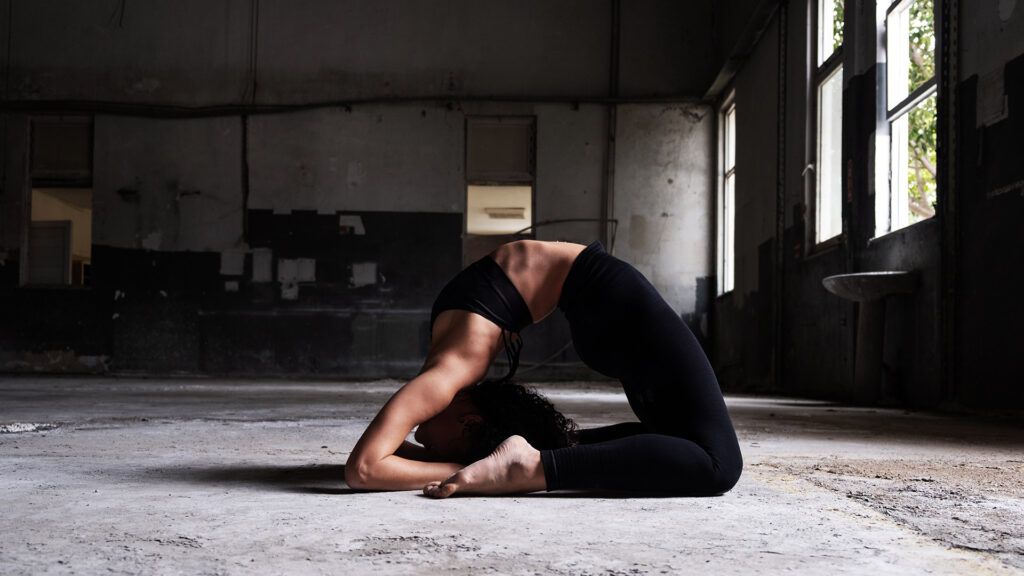A healthy spine has a gentle arch or curve. Arching your back excessively can tighten the muscles and lead to discomfort. However, arching the spine for brief periods should not cause health problems.
The upper half of the spine naturally curves inward, and the lower half, called the lumbar area, curves outward. “Arching” the back means pulling the buttocks and pelvis back, exaggerating the natural curve.
Excessive arching could misalign the body and result in pain or balance issues. Healthy posture aligns the spine and supports the body’s ability to stand straight and move flexibly. Not having a healthy posture can lead to an excessive arch in the back, called hyperlordosis.
This article looks at arching your back, including the potential benefits and risks. It also explains how to stretch the back safely.

Arching the back can have positive and negative effects, depending on the context and how a person moves their body.
Generally, it is best to avoid deliberately arching the back for prolonged periods. Eventually, excessive arching could lead to discomfort or muscle loss.
However, arching the back briefly during physical activity, such as yoga, has no negative health consequences.
People may arch their backs instinctively to alleviate discomfort or reduce tension in the spine.
For example, stretching the back may temporarily relieve stiffness or ease sciatica. Individuals who are pregnant or carrying excess weight may also arch their back to help with balance or compensate for weak core muscles.
Back arching can also occur during activities such as:
- stretching
- reaching for objects
- adjusting posture
Back arching and fitness
Individuals may incorporate back arching exercises into their fitness routines to help with:
- targeting specific muscle groups
- improving flexibility
- promoting spinal health
In disciplines such as yoga and Pilates, some postures include back arching to help increase flexibility, enhance core strength, and improve overall body awareness.
Weightlifters also often arch their backs deliberately while performing barbell squats and bench presses to try to increase stability on the bench and power output. However,
Arching the back during specific exercises such as backbends may have some benefits, including:
- Improved flexibility: Controlled back arching can enhance the flexibility of the spine and surrounding muscles, contributing to a better range of motion and reduced risk of injury.
- Strengthened core muscles: Certain back arching exercises engage the core muscles. Developing a stable and strong core improves posture and overall body strength.
- Pain relief: For some individuals with lower back pain, gentle back arching may provide temporary relief by stretching and relaxing tight muscles.
- Improved spinal health: Controlled back arching can promote spinal health by encouraging the spine’s natural curves and preventing excessive stiffness or rigidity.
Deliberately arching the spine for long periods is not a good idea. Doing so increases the risk of the following:
- Overexertion: Excessive or improper back arching can lead to overexertion and muscle strain, especially if a person moves without proper form or awareness. Using improper form during back exercises can increase the risk of injury and negate potential benefits.
- Spinal stress: Aggressive back arching may stress the spinal discs and joints, potentially leading to discomfort or injury.
- Chronic pain: Excessive or uncontrolled back arching may worsen symptoms of certain medical conditions, such as chronic back pain.
An excessive arch in the spine, also called hyperlordosis, can lead to the following:
- pain
- a slipped disk
- other injuries
When the spine is overly arched, it stresses the muscles of the abdomen, thighs, and hamstrings. As a result, these muscles may become unbalanced, tight, or weak, contributing to lower back pain.
Excessive arching can also affect gait and balance.
Certain types of back arching movements can exacerbate medical conditions, such as herniated discs or spondylolisthesis. In spondylolisthesis, the vertebrae
Stretching the back safely is crucial to prevent injury and promote flexibility and overall spinal health.
Here are some tips for safe and effective back stretching:
- Make sure you warm up: It is important to always warm up before attempting back arching exercises. Gentle stretches and movements can prepare the muscles and reduce the risk of strain.
- Maintain proper form: A person will need to maintain proper form during back arching exercises. They can engage their core muscles to support the spine and avoid excessive arching.
- Do controlled movements: It is best to perform back arching movements slowly and with control, avoiding jerky or sudden motions.
- Incorporate variation: People will need to incorporate various exercises to target different muscle groups in the back and promote balanced flexibility.
- Consult a professional: If a person has specific concerns or medical conditions, it is best that they consult a fitness trainer or healthcare professional for personalized guidance on safe back arching.
Excessive back arching for prolonged periods can lead to pain, injury, and muscle loss. It can also exacerbate certain spinal conditions, such as a herniated disc.
However, arching the back briefly during physical activity may have health benefits. When people arch correctly and safely, it can improve flexibility, strengthen core muscles, and promote spinal health.
People need to warm up and maintain proper form during back arching. They should also consult a professional if they have any underlying medical conditions or concerns to determine the best way to add back arching to their fitness routine.
